
Spilonota ocellana, the bud moth, is a moth of the family Tortricidae. It is found in the Palearctic realm, from North Africa and Europe to Iran, eastern Russia, China, Korea, and Japan. It is also present on Madeira and in North America.
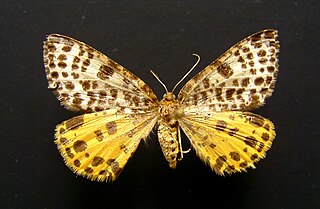
Arichanna melanaria is a species of moth of the family Geometridae. It is found over most of Europe, Mongolia, east to Japan.
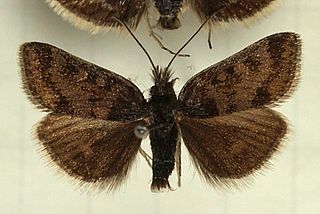
Metaxmeste schrankiana is a species of moth of the family Crambidae described by Siegmund von Hochenwarth in 1785. It is found in most of western Europe, including France, the Iberian Peninsula, Scandinavia, Germany, Austria, Switzerland, Greece and the Balkans.

Epinotia mercuriana is a moth of the family Tortricidae. It is found in most of Europe, east to the eastern part of the Palearctic realm.

Phalacropterix graslinella is a species of moth of the Psychidae family. It is found from France to southern Russia and from northern Italy to Fennoscandia and the Baltic region.
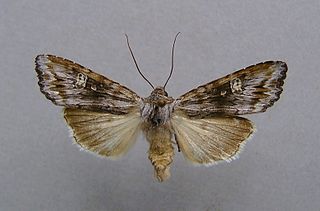
Lithomoia solidaginis, the golden-rod brindle, is a moth of the family Noctuidae. The species was first described by Jacob Hübner in 1803. It is found in most of Europe, except the Iberian Peninsula, Ireland, Iceland and the western and southern part of the Balkan Peninsula. Then eastwards to the Urals, Kamchatka and Japan.In the Alps it rises to about 1500 meters. It is found mainly on marshy ground, in humid mixed forests as well as in tundra - and taiga areas.
Carposina inscripta is a moth of the family Carposinidae. It was first described by Lord Walsingham in 1907. It is endemic to the island of Hawaii.

Coleophora glitzella is a moth of the family Coleophoridae. It is found from Fennoscandia and northern Russia to Italy and from Great Britain to Romania. It was recently reported from Yukon, Canada.

Luquetia lobella is a moth of the family Depressariidae. It is found in most of Europe, except Ireland, the Iberian Peninsula, Finland, Estonia and most of the Balkan Peninsula.

Levipalpus hepatariella is a species of moth of the family Depressariidae. It is found in most of Europe, except Ireland, Belgium, the Iberian Peninsula, Ukraine and most of the Balkan Peninsula. In the east its range extends to the eastern part of the Palearctic realm.
Udea inquinatalis is a species of moth in the family Crambidae. The species was first described by Friederike Lienig and Philipp Christoph Zeller in 1846. It is found in most of Europe and North America.

Nematopogon pilella is a moth of the Adelidae family. It is found in almost all of Europe, except Portugal, Spain and Slovenia.
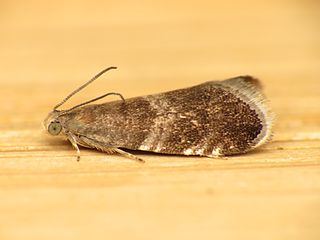
Strophedra weirana, the little beech piercer, is a moth of the family Tortricidae. It is found in most of Europe, except the Iberian Peninsula, part of the Balkan Peninsula, Ukraine, the Baltic region, Finland and Ireland.

Athrips pruinosella is a moth of the family Gelechiidae. It is found in western and northern Europe. It has also been recorded from the Caucasus, the southern Ural mountains, the Altai mountains, Tuva, Buryatia, the Amur region, Primorye and North America.

Chionodes continuella is a moth of the family Gelechiidae. It is found from most of Europe, east to Japan. It is also present in most of North America.
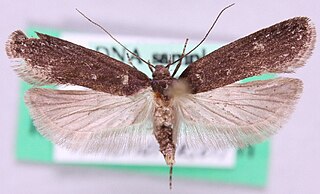
Neofaculta infernella is a moth of the family Gelechiidae. It was described by Gottlieb August Wilhelm Herrich-Schäffer in 1854. It is found in most of Europe and has also been recorded from North America.

Celypha rurestrana, the hawkweed marble, is a moth of the family Tortricidae. It was described by Philogène Auguste Joseph Duponchel in 1843. It is found in most of Europe, except Ireland, Lithuania, Ukraine and the western part of the Balkan Peninsula. It is also found in Turkey.

Paramesia gnomana is a species of moth belonging to the family Tortricidae, first described by Carl Alexander Clerck in 1759.

Spatalistis bifasciana is a species of moth of the family Tortricidae. It is found in most of Europe.
Dichomeris vacciniella is a moth in the family Gelechiidae. It was described by August Busck in 1915. It is found in North America, where it has been recorded from Nova Scotia, southern Quebec and southern Ontario to Florida, Michigan, Missouri and Arkansas.
















